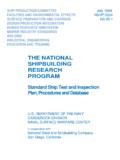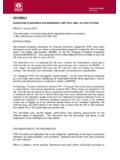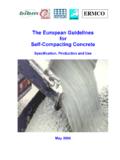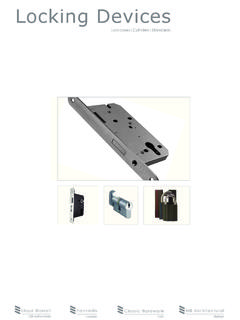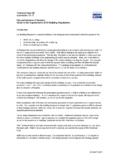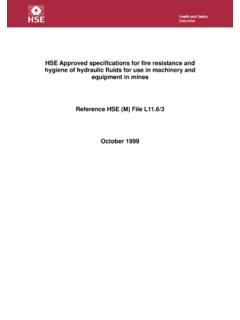Transcription of Fire Testing of Foams - Palziv - GalFoam
1 fire Testing of Foams The following Technical Information Pamphlet (TIP) examines fire /Flammability standards relevant to Cross-linked Polyethylene (XLPE) and Ethylene Vinyl Acetate containing Foams . Introduction Almost every application that uses XLPE Foams has its own fire standards . Each country's governing safety boards define their own standards . There are some "Internationally recognized" standards that are accepted for a number of fields (even though they were perhaps designated for one particular one), but until a unified "Euro-Standard" (or even, "World-Standard") is accepted, people in industry have to be aware of all of the possibilities that might confront them. There are also a couple of standards that were developed for particular materials and are used (often incorrectly) to test other types of materials.
2 It is important that the customer and manufacturer agree on WHAT EXACTLY IS REQUIRED prior to ordering the wrong material. The flame retardant additives that are most often used in XLPE foam materials are Halogenated Hydrocarbons combined with an Antimony Trioxide synergist. Recent European rulings have banned the use of some of these materials and particularly for Electrical and Electronic applications, the terms "RoHS" and "RoHS compliant" are being heard more and more. In reality, these materials are simply free of "Deca-DBE"(and other Polybrominated diphenyl ethers). Table 1. List of FR standards and applications Standard Country Application Din 4102 B1/B2 Germany Construction BS 476 Part 6/7 UK Construction Class 1 Italy Construction M France Construction F France Train/Construction M Spain Construction UL94 USA Electrical FMVSS302 / EC Directive 95/28/EC Annex IV USA/EU Automotive DIN 4102 B1/B2(German) Small fire test - DIN 4102 B2 B2 - The specimen is suspended vertically and a 20mm high flame is applied for 15 seconds to both the foam surface and edge.
3 5 samples are tested. The production of flaming droplets is determined by a piece of filter paper being placed below each specimen during Testing . A B2 classification is achieved if the tip of the flame does not reach a reference line marked on the foam within 20 seconds (150mm for bottom edge application, 40 and 190mm from the lower edge for face or side application). Pipe insulation is one application where DIN4102 is the "standard" fire test fire shaft test DIN 4102 B1 BS 476 Part 6/7 (British) The British "Standard" 476 is actually a series of fire standards . Part 6 and 7 are Surface spread of flame tests (these are to prevent fire spreading to adjoining buildings). These standards are used in construction for the UK, British Commonwealth and countries that were previously part of the British Empire.
4 BS 476 Part 7. Surface spread of flame This test shows how the spread of flames across the surface of a material gives an indication as to its ability to spread fire . The sample is mounted in a water-cooled holder and exposed to the radiant panel for 10 minutes with a pilot flame applied for the first minute of the test. The progression of the flame front is measured after 11/2 minutes and at the end of the test. The test grades material from 1 (best) down to 4 (worst). B1- The samples are held vertically in a supporting frame within a square shaped vertical housing (the Brandschafht , or fire schaft). A gas burner subjects the samples to flames for 10 minutes. At the same time a constant, uniform flow of air is blown into the Brandschacht from below. In evaluating the test, smoke gas temperature and the length of the specimen which has escaped burning (residual length) are taken into account.
5 For a B1 classification foam must show: 1. A mean residual length of not less than 150mm, with no specimen being burned away completely. 2. A mean smoke gas temperature of less than 200oC. BS 476 Part 6. fire Propagation This test measures the rate of heat release during combustion. Heat release during combustion will affect the rise in temperature of the surrounding un-burnt material and the subsequent rate of spread of fire . The sample is mounted and subjected to 14 gas jet flames at intervals across the sample width. Two electric heaters generate a high background temperature. The temperature rise is measured using thermocouples and compared with the rise obtained with a standard asbestos cement board specimen. "Class 1"- CSE RF 2/75 A / CSE RF 3/77 - Surface application and spread of flame test ( Italy) To achieve an overall classification a small burner ignitability test (CSE RF 1/75 A or CSE RF 2/75 A) must be conducted together with a surface spread of flame test (CSE RF3/77).
6 The results of both tests are then used to determine an overall classification, from Class 1 (the best) to Class 5. CSE RF 2/75 A uses surface application of a small flame for 30 seconds. After flame time, afterglow time, extent of damage and flaming droplets are observed and recorded these parameters are then divided into three grades, as shown in the table below: Air conditioning duct insulation in Italy has the requirements of "Class-1". CSE 3/77 Surface spread of flame test . "M" Class- NF P 92 503/NF P 92 504/ NF P 92 505 + "F" tests - STM S-001 (France) NF P 92 510 Determination of upper calorific potential NF P 92 503 Electrical burner test used for flexible materials 5 mm thick or less Complementary tests : NF P 92 504 Speed of spread of flame test used for the materials which are not intended to be glued on a rigid substrate NF P 92 505 Dripping test with electrical radiator, used for melting material STM S-001 (Smoke): NF X 70 100 Analysis of pyrolysis and combustion gases NF X 10 702 Determination of the smoke opacity in a non-renewed atmosphere "M Class" Construction The sample is exposed to a small pilot flame and radiant panel.
7 The position of the sample is varied to simulate end use in floors, walls and ceilings. Parameters measured are the rate of spread of flame, extent of damage, afterglow and flaming droplets, which are again divided into three grades. The category on which classification is based is worked out by multiplying the different grades with various weighting factors, which for flaming droplets are distinguished between floor, wall and ceiling use. The categories from the different tests then form the basis for classifying products. The French test known as the "Breleur electrique" - electric burner - is the principal method used not only in France, but also in Belgium, Spain and Portugal. It results in a classification of M1 to M4, with M1 being the highest classification. The sample is placed face down on the test rig at an angle of 30o above an electric radiator which gives out heat.
8 A small butane gas pilot flame is applied directly to the foam surface at 20 seconds into the test, held in position for 5 seconds then withdrawn. The flame is applied again at 45 seconds and subsequently every 30 seconds for the duration of the 5 minute test. If any flaming continues after 5 minutes, the test is continued until the specimen extinguishes completely. The following aspects are noted during the test:- - duration of flaming - production of burning droplets - length/width of the damaged specimen Actual classification requirements are given below:- Classification M1 M2 M3 >M3 Duration of Combustion s <=5 >5 >5 >5 Length mm - <350 <600 600 Damaged Width mm - - <90 >90 Droplets none none none The NF P 92-504 Bunsen burner Test for Small-ignition Source Flammability.
9 This complimentary test to the Electric Burner helps establish a classification on samples which behave unusually during the primary test - for example, melting rapidly or shrinking away to form a hole so that the pilot flame cannot come into contact with the sample at 20 seconds, or if samples were unable to achieve an M3 rating. The NF P 92-503 Electrical burner test "F" Class Railway/ Construction For materials which melt or shrink away from the heat source, after flame, non-propagation of flame and burning/non burning droplets are observed. Rate of flame spread is also measured if the material does not achieve M3. The non-propagation of flame test involves a flame being held against the free end of a horizontal sample, 10 times for 5 seconds; the time of after flame is measured.
10 In the flame spread test, the time taken for flame to spread between two reference marks at 50mm and 300mm is established. The production of burning droplets is also noted. Classification criteria are given below: Classification M1 M2 M3 a M3 b M4 Duration of Combustion none <5s <5s >5s >5s Droplets None or non burning None or non burning Burning None or non burning Burning The NF P 92-505 Dripping Test The "reaction to fire " tests classify the material in 5 categories from M0 to M4. The specific standard that is applicable depends on the intended use (see table below). Class M0 is assigned if the requirements for class M1 are met and the heat of combustion (upper calorific potential test by NF P 92-510 does not exceed 2500 kJ/kg (typical M0 material are concrete, blaster, mineral based product).)

